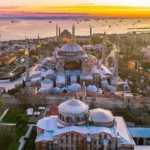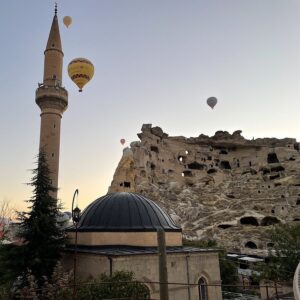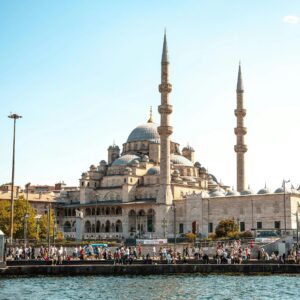Pamukkale’s stunning white travertine terraces and thermal pools are a must-see, alongside the ancient ruins of Hierapolis, including its grand theater and Cleopatra’s Pool. Visit in spring or fall for pleasant weather and fewer crowds. Explore the mineral-rich pools for relaxation, and wear water shoes for comfort. Nearby, Laodicea and Aphrodisias offer more history, while Denizli’s markets serve delicious gözleme and kebabs. Keep going to uncover the best tours and hidden gems.
Key Takeaways
- Explore Pamukkale’s terraced hot springs and Hierapolis ruins, including Cleopatra’s Pool and the Roman Theater.
- Visit during spring or autumn for ideal weather, fewer crowds, and affordable accommodations.
- Experience the healing thermal pools and nearby natural attractions like Kaklık Cave and Lake Salda.
- Discover ancient sites such as Laodicea and Aphrodisias for a deeper historical and cultural immersion.
- Enjoy local cuisine like gözleme and kebabs while exploring Denizli’s vibrant markets.
Must-See Attractions in Pamukkale
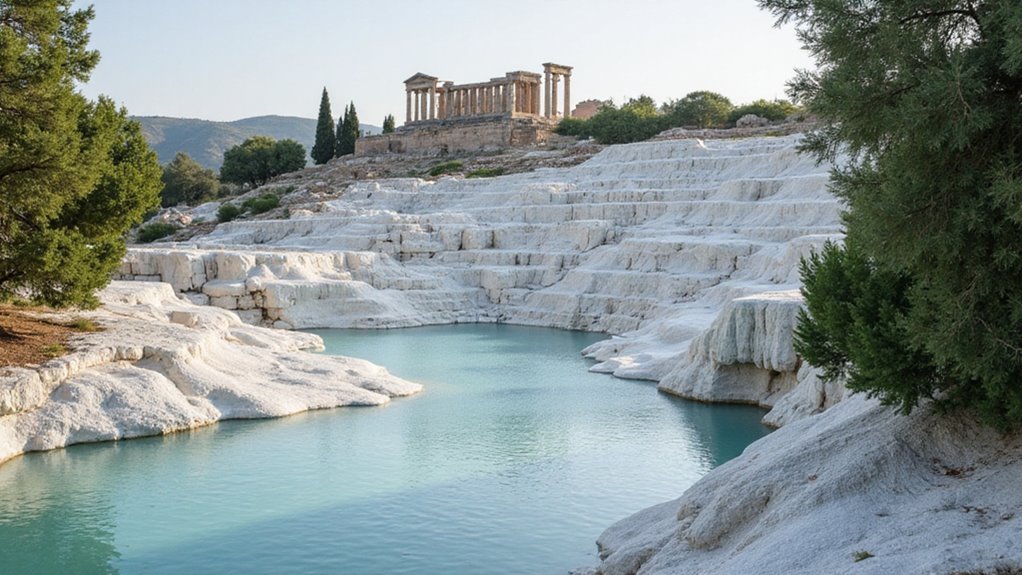
When you visit Pamukkale, you’ll be amazed by its iconic travertine terraces, which are a natural wonder of shimmering white mineral pools. You can stroll barefoot across these thermal pools, feeling the warm, mineral-rich water on your skin.
Hierapolis, the ancient city perched above the terraces, offers a glimpse into Roman history with its well-preserved amphitheater, necropolis, and ancient baths. You’ll find freedom in exploring these historical sites without crowds if you time your visit right.
Step into history at Hierapolis, where Roman ruins and thermal baths await—explore freely with fewer crowds at the right time.
Don’t miss Cleopatra’s Pool, where you can swim among submerged Roman columns. The Roman Theater is another must-see attraction that showcases the grandeur of the ancient city.
Pamukkale also invites you to savor local cuisine at nearby restaurants, offering delicious Turkish kebabs, gözleme, and baklava.
Throughout the year, cultural events like traditional music performances and festivals bring the area to life.
Combine relaxation with discovery as you soak in the thermal waters, hike through ancient ruins, and immerse yourself in Turkish culture. Pamukkale is a destination that lets you wander freely, connecting with nature and history.
Best Time to Visit Pamukkale
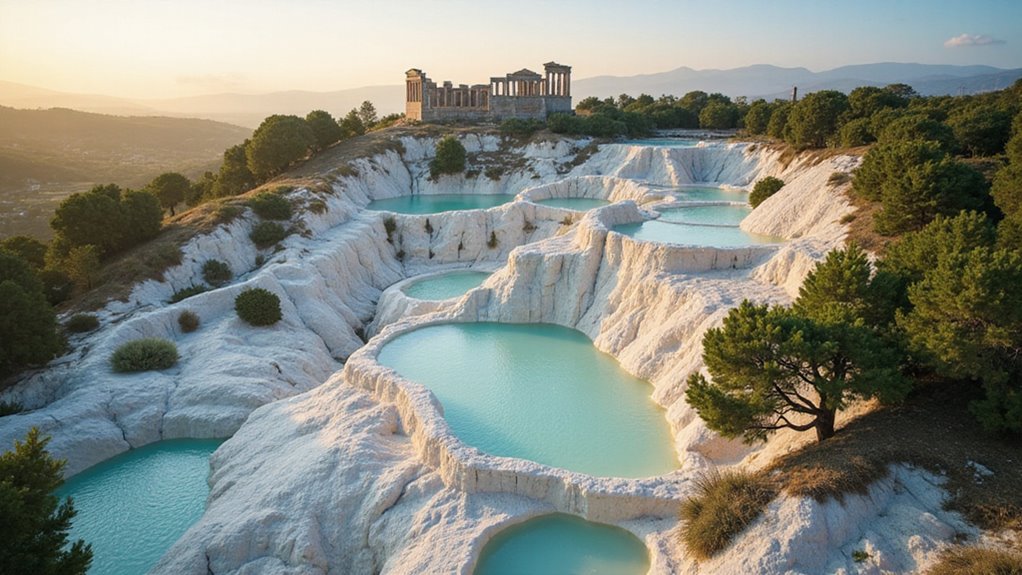
Pamukkale’s stunning travertine terraces and ancient ruins are best enjoyed during specific times of the year. For ideal weather conditions, plan your visit in spring (April to June) or autumn (September to October). These seasons offer mild temperatures, perfect for exploring the terraces, Hierapolis, and Cleopatra’s Pool without the summer heat or winter chill.
Summer months (July to August) can be scorching, making midday visits uncomfortable, though early mornings or late afternoons are manageable. Winter (November to March) brings cooler weather, but the terraces’ beauty remains, and crowds are thinner.
Travel logistics are smoother during shoulder seasons, with fewer tourists and more affordable accommodations. Avoid public holidays and peak summer weeks if you prefer a quieter experience. For a more immersive visit, consider booking a guided tour to skip the lines and learn fascinating details about the site’s history.
Pamukkale’s natural and historical wonders shine year-round, but timing your trip guarantees you’ll enjoy the best of its landscapes and attractions without unnecessary hassle. Choose wisely, and your visit will be unforgettable.
How to Get to Pamukkale
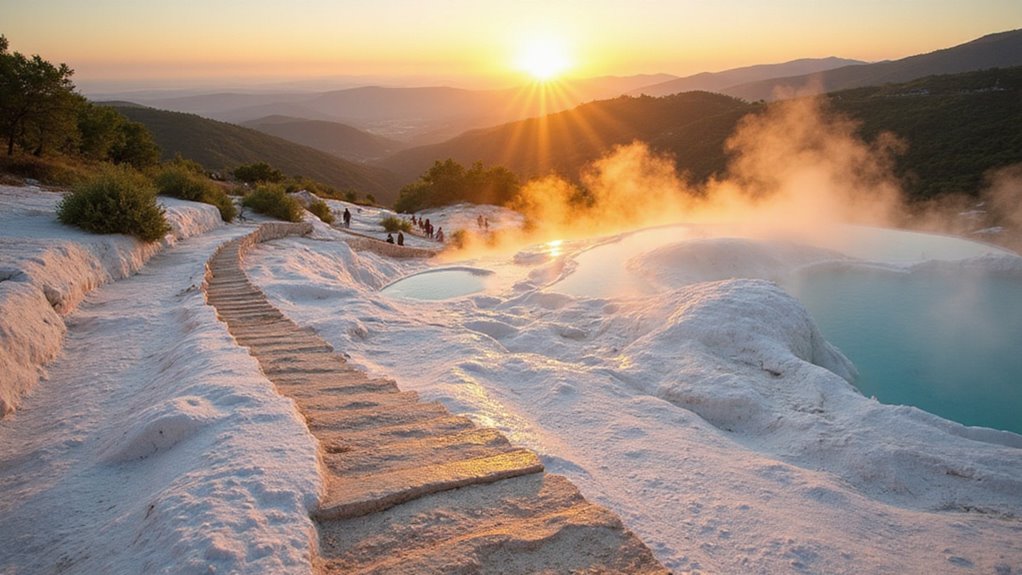
Several convenient options make reaching Pamukkale’s breathtaking travertine terraces and ancient ruins a seamless experience.
If you’re flying in, the nearest airport is Denizli Çardak Airport, just 70 kilometers away. From there, you can take a shuttle or rent a car for a scenic drive.
For a more adventurous journey, hop on a bus from major cities like Istanbul, Ankara, or Izmir—comfortable and affordable transport options abound. Trains are another great choice, with Denizli’s station well-connected to the national rail network.
Once in Denizli, local minibuses, or dolmuş, will whisk you to Pamukkale in under 30 minutes. Explore the Hierapolis ruins, including the Roman Theatre and Cleopatra’s Pool, for a deeper dive into history.
Travel tips include booking tickets in advance during peak seasons and checking schedules for early departures. For those short on time, consider booking a Pamukkale day tour from Istanbul, which includes round-trip flights and guided exploration.
Whether you prefer the freedom of driving or the ease of public transport, getting to Pamukkale is straightforward and rewarding, setting the stage for an unforgettable adventure.
Exploring the Thermal Pools
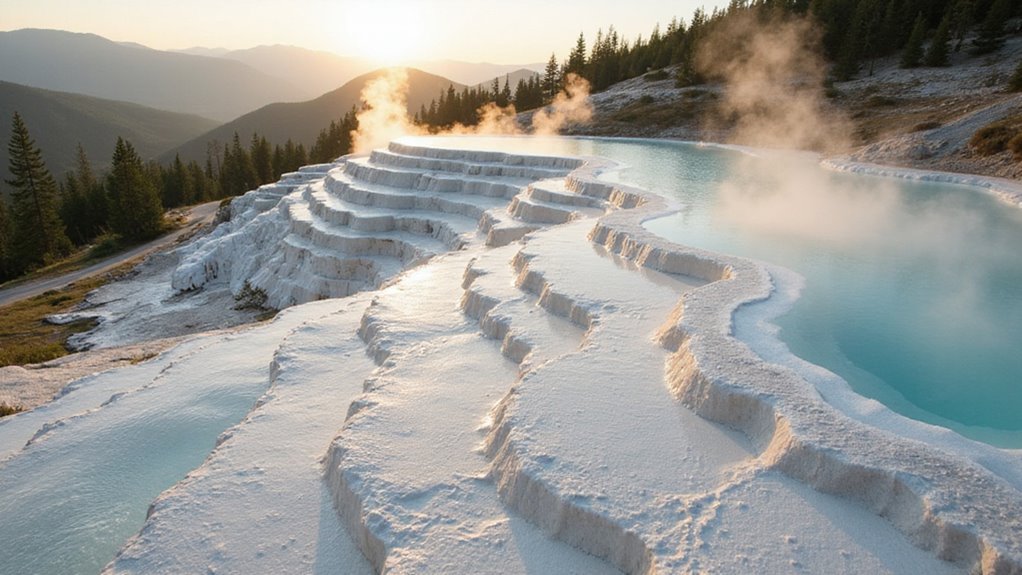
After arriving in Pamukkale, you’ll find its gleaming white thermal pools ready to captivate you.
These natural wonders, formed by mineral-rich waters cascading over terraces, create a surreal landscape of unique formations. The travertine terraces, shaped over millennia, offer a one-of-a-kind experience as you walk barefoot on their smooth, warm surfaces.
Immerse yourself in the thermal pool benefits, which include soothing muscle relaxation and skin rejuvenation due to the high calcium and magnesium content. The warm, turquoise waters invite you to unwind while surrounded by breathtaking views of the valley. Nearby, the ancient city of Hierapolis offers a glimpse into Roman history and complements the natural beauty of Pamukkale. For a deeper historical connection, consider exploring the Celsus Library, a marvel of ancient architecture.
Don’t miss the chance to explore the smaller, secluded pools tucked away in the terraces, perfect for a tranquil escape. Remember to bring water shoes for comfort and a camera to capture the ethereal beauty.
Pamukkale’s thermal pools are a must-visit for anyone seeking freedom, relaxation, and a connection with nature’s wonders.
Discovering the Ancient City of Hierapolis
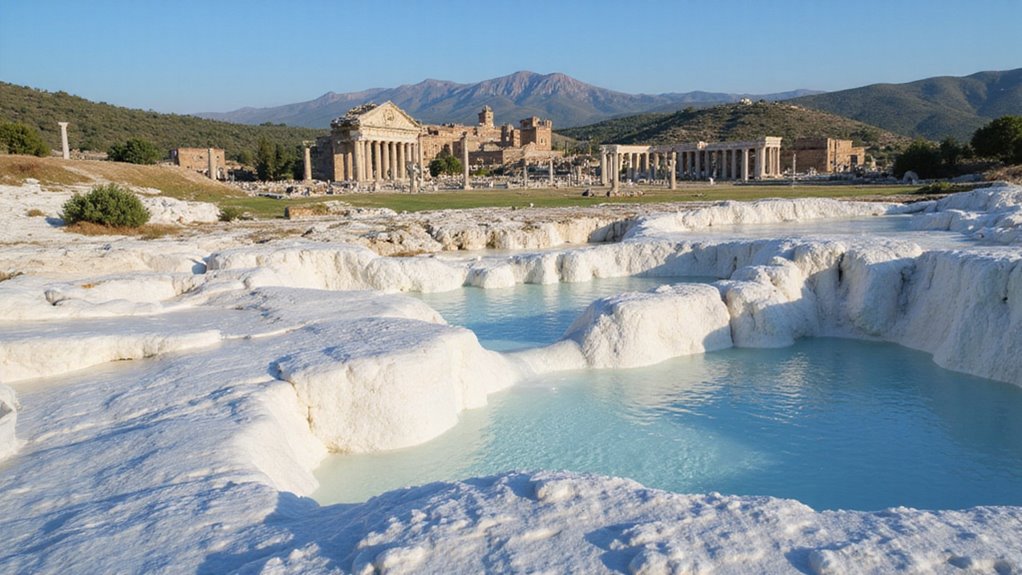
Ever wondered what secrets lie within the ruins of Hierapolis? This ancient city, perched above Pamukkale’s terraces, whispers tales of Roman grandeur and spiritual healing.
Wander through its well-preserved streets, where towering columns, a grand theater, and sacred temples reveal its cultural significance. Hierapolis isn’t just a collection of ancient ruins—it’s a gateway to the past, where you’ll find the Plutonium, a mysterious cave once believed to be the entrance to the underworld. Like Ephesus, another iconic heritage site, Hierapolis offers a deep dive into ancient history.
Don’t miss the Necropolis, one of the largest burial sites in Anatolia, with tombs stretching for miles. The Antique Pool, fed by thermal springs, invites you to swim among submerged Roman columns.
Hierapolis offers freedom to explore at your pace, with panoramic views of the valley below. Pack comfortable shoes, a camera, and curiosity—this UNESCO site rewards every step with history’s echoes. The thermal waters of Hierapolis were renowned by Roman emperors for their healing properties, making it a must-see destination.
Tips for a Smooth Pamukkale Experience
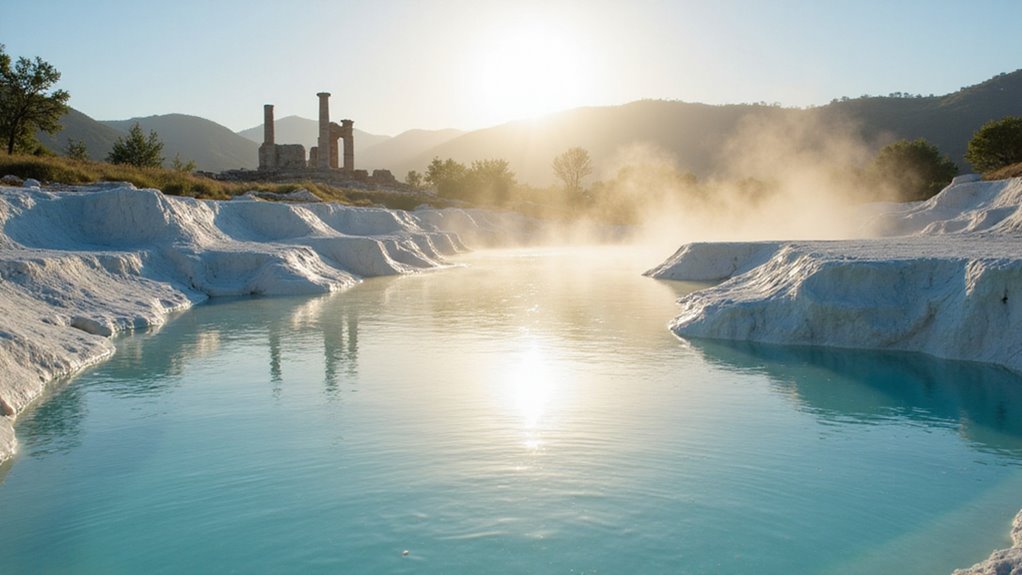
Pamukkale’s iconic travertine terraces, with their shimmering white pools and thermal waters, offer a stunning backdrop for your visit. To make the most of your trip, pack essentials like comfortable water shoes, sunscreen, and a reusable water bottle.
The terraces can be slippery, so sturdy footwear is a must. For photography tips, visit early morning or late afternoon to capture the soft, golden light reflecting off the pools. Use a polarizing filter to reduce glare and enhance the vibrant blues of the thermal waters. Consider combining your visit with a trip to Hierapolis, an ancient city that offers significant ruins and historical insights.
Respect the site’s rules by staying on designated paths to preserve the delicate formations. Bring a lightweight towel and a change of clothes if you plan to soak in the warm, mineral-rich pools. Consider enhancing your trip with a Private Aphrodisias Day Tour to explore the nearby UNESCO World Heritage Site known for its impressive ruins and serene atmosphere.
Pamukkale’s beauty is best enjoyed at a relaxed pace, so allow ample time to explore and unwind. With these tips, your experience will be as seamless as the terraces themselves.
Nearby Attractions and Day Trips
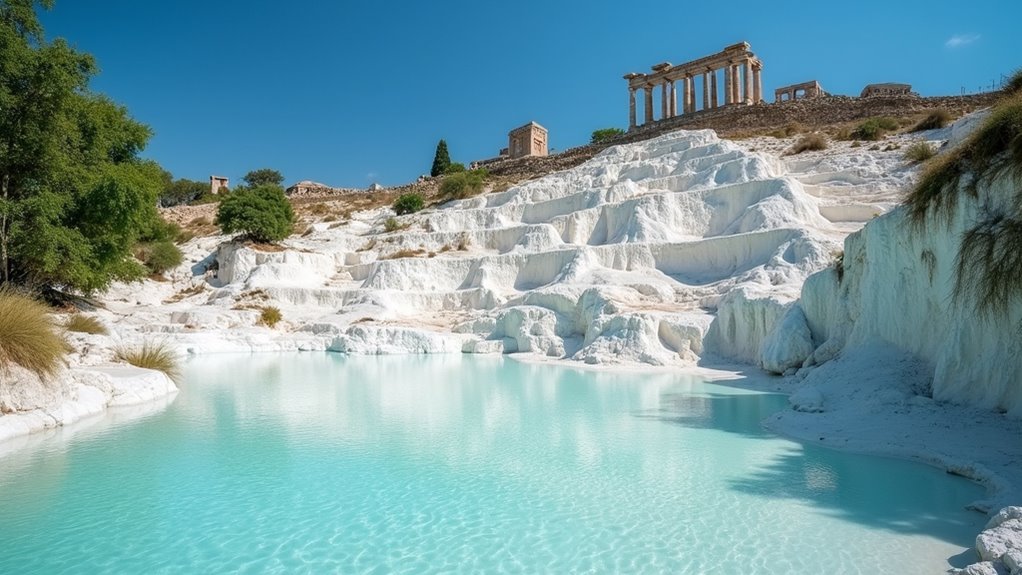
Exploring the area around Pamukkale reveals a wealth of fascinating destinations that’ll enrich your journey.
Hierapolis, an ancient city atop the travertines, offers stunning ruins and a glimpse into Roman history. Laodicea, just 15 minutes away, boasts well-preserved theaters and temples.
For a deeper exploration into cultural experiences, visit Aphrodisias, a UNESCO site with a magnificent stadium and museum. If you’re craving local cuisine, head to Denizli’s bustling markets for authentic dishes like gözleme and kebabs. For a unique stay, consider a boutique cave hotel in nearby Cappadocia, offering a blend of comfort and history.
Nature lovers can explore Kaklık Cave, a hidden gem with striking underground formations. For a serene escape, Lake Salda’s turquoise waters and white sands are perfect for relaxation.
Day trips to these spots are easy, with guided tours or public transport options. Each destination offers unique insights into Turkey’s rich heritage and natural beauty, making your Pamukkale adventure unforgettable.
Frequently Asked Questions
Can I Bring My Pet to Pamukkale?
Picture your furry friend trotting beside you, tail wagging under the warm sun. You’ll need to check pet policies, as not all areas welcome pets. Look for pet-friendly accommodations nearby to guarantee they’re comfortable too.
Are There Any Age Restrictions for the Thermal Pools?
You won’t face strict age limits, but pool safety matters—kids should be supervised. The thermal pools are open to all, though slippery surfaces demand caution. You’re free to enjoy, just watch your step!
Is Photography Allowed in All Areas of Pamukkale?
Photography’s allowed in most areas, but you’ll need to respect the photography etiquette—avoid drones and restricted zones. For the best photo spots, head to the travertine terraces or Hierapolis ruins for stunning, unrestricted views.
Are There Vegetarian or Vegan Food Options Nearby?
Craving a taste of freedom? You’ll find vegetarian and vegan options nearby, blending health benefits with the richness of local cuisine. From vibrant salads to hearty lentil dishes, your plate’s as free as your spirit.
Can I Visit Pamukkale During Religious Holidays?
You can visit Pamukkale during religious holidays, but you’ll likely encounter holiday crowds. Be mindful of local religious customs, as some services or attractions might adjust their hours. Plan ahead to enjoy your visit freely.






